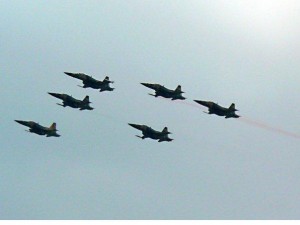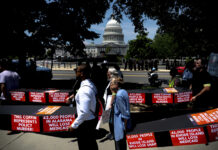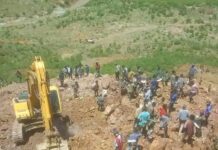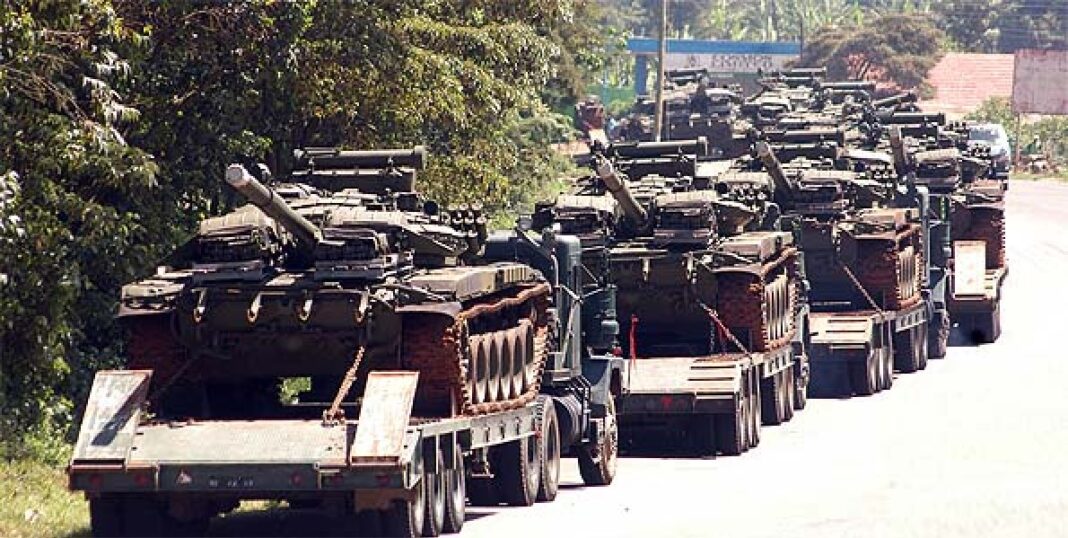By Wanjohi Kabukuru
When Kenya’s Defense Forces invaded southern Somalia this fall, with troops pouring in by air, sea and land, the Nairobi government justified the actions on foreign soil by citing a string of recent kidnappings and murders at resorts and at a refugee camp along Kenya’s northern coast.
Intelligence and law enforcement officials traced the attacks to Al Shabaab, the violent Al Qaeda proxy based in Somalia, Kenya’s neighbor to the north. Al Shabaab neither denied the accusations nor condemned the assaults.
The attacks were horrific enough. In the first, a British honeymooner was killed on the island resort of Lamu, and his bride kidnapped. In the second, an elderly French woman on holiday, a paraplegic, was kidnapped, also from Lamu. Then, two Spanish aid workers were abducted from Dadaab, the world’s largest refugee camp, also in northern Kenya.
Kenya’s response was swift: Citing Article 51 of the United Nations Charter on October 16th 2011, joint forces of the Kenya Army, Navy and Air Force invaded Southern Somalia under the banner “Operation Linda Nchi” (Operation Defend the Country).
Though the incursion by the Kenyan Defense Forces appeared to have been motivated by the kidnappings, Kenya had in fact been quietly laying the diplomatic and military foundation for an invasion of Somalia over the last three years. Behind the scenes, it trained breakaway Somali forces and worked to overcome international misgivings over the so-called Jubaland Initiative, which aims to create a distinct entity in the border region that would be friendly to the Nairobi government.
As envisioned by officials in Nairobi, Jubaland would be comprised of the Gedo, Lower Juba and Middle Juba areas of southern Somalia, along Kenya’s northern border.
The establishment of Juba, according to one school of thought among Kenya’s foreign policy and security mandarins, would act as a “buffer zone,” or a neutral area to safeguard Kenya from the conflict cauldron of the wider Somalia. It would also, they argued, stem the tide of piracy, curtail terrorism, control refugee upheavals, and cut off the flow of small arms and contraband into Kenya. The second school of thought sees Jubaland as the foundation from which a stable Somalia could emerge.
The “Jubaland model” is fashioned from precedents in Puntland and Somaliland–two provinces in northern Somalia that broke away from Mogadishu and declared their own autonomous governments following the ouster of President Siad Barre in 1991. As opposed to the rest of Somalia, these two northern counties enjoy relative stability.
Kenya’s Defense Minister Yusuf Haji is also a member of parliament, representing Ijara in northern Kenya, and key leaders of the Kenyan Somali community have already lent their support for Kenyan military incursion.
“Whatever they call it, whether Jubaland, or Puntland, whichever set up, so long as it will address the issue of terrorism that is taking root on the Somalia side, is welcome,” says Abdikadir Hussein Mohamed, a member of the Kenyan parliament from Mandera Central, which borders Somalia. Abdikadir, who chairs the parliament’s powerful Constitution Implementation Oversight Committee, is considered a rising start in Kenyan politics. The young Harvard law graduate is a partner in Ahmednasir Abdikadir and Co., whose clients include Kenya’s intelligence services.
Supporters of the Jubaland plan point to the persistent instability of Somalia. Since the fall of Barre’s government exactly 20 years ago, they note, Somalia has never enjoyed peace, nor even a unified government accepted by all sectors of the population. Rather, Mogadishu has hobbled from one regime to the next, failing to establish a unified central government. The current UN-backed Transitional Federal Government, which was born and weaned in Kenya seven years ago and nurtured under the Djibouti Peace process in 2008-2009, has been unable to stamp its authority in all of Somalia.
Painful and fatal leadership experiments have eroded the core of Somalia for the last two decades. Since late 2006, military analysts say, Somalia has also become a fertile breeding ground for extremists, terrorists and pirates. The annual economic costs associated with piracy now stand at a staggering $12 billion according to the International Maritime Organization, an agency of the United Nations. In 2010, the International Maritime Bureau, a division of the International Chamber of Commerce, reported a record 1,181 seafarers were kidnapped, of which 1,016 led to demands for ransom in Somalia. In 2009, the bureau estimates, Somali pirates collected some $238 million in ransom money alone.
Al Shabaab emerged as a distinct force in Somalia in 2007, after the collapse of the Islamic Courts Union, whose capital was in the port city of Kismayo. Al Shabaab, which appears to be a mutant of the Islamic Courts Union, controls the same areas the Islamic Courts ruled–Central and Southern Somalia. Al Shabaab has never denied its links to terrorism and piracy. U.S. officials believe Al-Shabaab functions as Al Qaeda’s franchise in Somalia, with influence throughout Africa.
Initially, Kenya’s plan to enter Somalia was opposed by Washington and even Kampala. Ethiopia’s premier Meles Zenawi was quoted in WikiLeaks doubting Kenya’s tactical capacity to wrestle Al Shabaab from her stronghold in Somalia’s southern prefectures. Zenawi’s misgivings were based on Ethiopia’s failed 2006 military incursion into Somalia, and on Addis Ababa’s fears that the support Kenya gives to transitional government forces in Jubaland may shift to the Oromo National Liberation Front (ONLF), a self-determination movement operating in Ethiopia’s Ogaden region.
Though the Jubaland Initiative evolved largely out of the public eye, it was not entirely a secret. Its contents were the subject diplomatic discussions in Washington, Addis Ababa, Kampala, Nairobi and even Mogadishu–discussions that turned up in U.S. diplomatic cables released by Wikileaks. What was not known was the timing, and just how events on the ground would propel Kenya’s Jubaland Initiative to become one piece in a coordinated international response to Somalia’s instability.
Despite Zenawi’s initial doubt, Kenyan officials prevailed upon the Ethiopian leader to remember the two countries’ long-standing difficulties with their common neighbor. In 1964, Ethiopia and Kenya signed a binding defense pact solely in response to Somalia’s claims to vast regions of the two countries. This pact has continuously been renewed in the last 40 years to reflect the changing tumultuous realities in the Horn of African region.
Sources said Ethiopia’s change of heart emanated out of envy and a bruised ego. As international support coalesced around the on-going military response, Kenya had positioned itself to gain a foothold in Somalia, and Nairobi was fast becoming Africa’s preferred recipient of Washington’s military aid.

Exactly one month after Kenya moved into southern Somalia, Ethiopia once again sent troops into eastern Somalia, setting aside the disastrous results of its earlier invasion. This strategy, boosted by the 9,000 Uganda-led African Union peacekeeping force in Mogadishu, AMISOM, and the European Union’s Naval Forces, together with the US led Combined Task Force 150 and 152 in the Indian Ocean, reveals a wider scheme aimed at closing in on Al Qaeda’s sympathizers holed up in Somalia.
For his part, Ugandan President Yoweri Museveni derided the Kenyan military as a “career army,” inexperienced in combat. Washington, too, initially saw it as a costly venture for Kenya.
At a recent African Union meeting in Addis Ababa, both Kenya and Ethiopia began fresh talks of bolstering the AMISOM troops currently stationed in Mogadishu in addition to their forces in southern and eastern Somalia.
In putting together its plan of action, Kenya fully supported Somalia’s former defence minister Mohammed Abdi Mohammed (also known as Muhammad Gandhi) as Jubaland’s elected president, and for the last three years trained close to 3,000 Somali soldiers in readiness for formalizing Jubaland as an autonomous entity. Events currently underway in Somalia reveal a split within the transitional government. Somalia’s President Sheikh Sharif Ahmed initially opposed Kenya’s incursion, while Prime Minister Abdiwali Mohamed Ali and Defense Minister Hussein Arab Isse are supporting Kenya’s moves.
President Sharif has made no secret of his unease over Kenya’s liaison with the influential Ogadeni clan, which supports the Jubaland Initiative. In it, Sharif sees the seeds of a wider scheme for Jubaland to breakaway from Somalia, and dilute his authority.
Kenya literally ignored the opposition. Instead, soon after its military crossed into Somalia–ostensibly to lend support to Somali government troops trained in Kenya–it embarked on a diplomatic charm offensive to win over doubting nations. Key allies roped in on this were the European Union, the United States, the East African Community bloc, Inter-Governmental Authority on Development and the African Union.
More than a month since Kenya cushioned the transitional government forces into the entire Southern sector of Somali; it is no longer a Kenyan-only affair. The United States, European Union and the regional bloc nations have all lent their support to the war. U.S. Air Force Reaper drones and the French Navy have reportedly joined the onslaught against Al Shabaab. The drones, equipped with Hellfire missiles and satellite guided missiles, are controlled from the Arba Minch airbase in southern Ethiopia by the U.S. 17th Air Force which runs Africa’s operations.
Great Britain is also lending its support. Speaking to the House of Lords, David Howell, the Minister of State, Foreign and Commonwealth Office, said the United Kingdom “supports Kenyan action so long as it is undertaken in co-ordination with the Transitional Federal Government and complies with international law.” Howell added, “The Kenyan military operation is a response to the invasions into Kenya by Al Shabaab and other forces, and it is important to note that it is an attempt undertaken with the support of the TFG in Mogadishu to bring some order and control to the situation.”
Elias Bare Shill, a former member of the Kenyan legislature representing Fafi in northern Kenya, supports the Jubaland Initiative, and sees it as securing Kenya’s geopolitical and economic interests in the Horn of Africa trouble spot.
“The Jubaland Initiative will be Kenya’s first major attempt to reassert its influence in a country that has posed a major social and security nightmare for the last two decades,” Shill said. “Jubaland will not just help us with security; it will open the trade route between Kismayo and Garissa.” Kismayo, considered Al Shabaab’s capital, is southern Somalia’s major operational center and commercial port. Garissa is Northern Kenya’s regional capital and economic hub.
A closer look at Kenya’s Jubaland Initiative supports Shill’s assertions. The country’s largest development project, dubbed LAPSSET (Lamu Port Southern Sudan Ethiopia Transport) Corridor, puts $25 billion dollar into linking sleepy Lamu island in the western Indian Ocean shelf to the oilfields of Southern Sudan, and to open up the trade route into the emerging market of Ethiopia.
LAPSSET is the flagship project of a broader program called Kenya Vision 2030, which aims to transform Kenya into an industrialized nation by the year 2030. The project passes along northern Kenya near the borders of Somalia, Ethiopia and Southern Sudan.
A stable autonomous Jubaland acting at the behest of Kenya guarantees the security of this multi-billion dollar undertaking, and other geo-strategic interests. According to the Kenyan military’s chief of general staff, General Julius Karangi, the Kenyan offensive in the entire southern stretch of Somalia has no fixed time frame. “When the Kenyan government and the people of this country feel they are safe enough we shall pull back,” he told 100Reporters.
Visualized in the LAPSSET is a 32-berth state-of-the-art port at Lamu, an oil refinery, a 1,620-kilometer railway line to Southern Sudan with a branch line to Ethiopia, a 1,300-kilometer oil pipeline linking Lamu with the oil fields of Southern Sudan, and a 1,720-kilometer superhighway connecting to Ethiopia and Southern Sudan. As part of the LAPSSET project, Kenya also plans to upgrade three resort cities, with new international airports at Lamu, Isiolo and Lokichogio. When complete, the Lamu port will be the largest port on the African continent.
In disrupting Al Shabaab’s terror links and curtailing piracy, Kenya, Ethiopia and Uganda are lashing their own economic interests to the larger anti-terrorism proxy war, with the support of the United States and the European Union. But the ultimate goal of a united Somalia, complete with a stable popularly elected central government, is still far from reality.
Top photo: Kenyan Army convoy heading into Somalia. REUTERS.







I could say it is totally impossible to have a United somaliland ever, Look at the Ethiopian, kenyan and djiboutian interests. This can never happen becasue anyone craving this impossible option will immidiately be hammered by all these countries which is even impossible leave alone for the wartorn Somalia even for a developed nation.
Reuters says: “Al Shabaab emerged as a distinct force in Somalia in 2007, after the collapse of the Islamic Courts Union…” But how did they collapse? The U.S. and other western powers chased them into the sea! Now we regret it but it’s a little late…